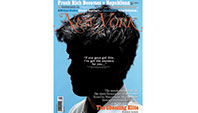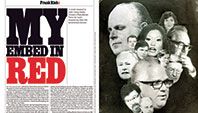
1. “Today’s high-school students don’t have a firm grasp on the true purpose of education nor what academic achievement means,” wrote one reader on nymag.com about Robert Kolker’s profile of the Stuyvesant High School junior at the center of the biggest cheating ring in the exclusive school’s storied history (“Cheating Upwards,” September 24). “The most fascinating part of this is the communality,” wrote another commenter. “These kids don’t seem to be competing with each other—they help each other. They are busting the system, but they have their own code of ethics.” Some felt the culture of cheating was, if startling, actually not so unusual. “I went to Columbia and Harvard Law and the cheating … covering up, and the concomitant collusion I saw among students and faculty was mind-blowing. These are the type of people that destroyed the economy. It’s the motto of my generation and now their children: Take as much as you can, irrespective of the other guy; the rules don’t apply to you; the only failure is getting caught.” Another reader agreed: “We live in a society that teaches people that results are what matters. And as long as you (a) don’t get caught or (b) can ensure that the returns outweigh the costs—it’s okay.” But one alum wrote in to say however loud the fuss over this spring’s scandal, it was always thus. “From Stuyvesant ’82. We didn’t get caught. Dumb-asses.”

2. “Away from the convention stage and from the mainstream media’s coverage of it, dissension of various stripes was rife throughout the GOP coalition,” wrote Frank Rich, in an essay documenting his “attempt to put myself in the Republican brain by spending a solid week listening to, watching, reading, surfing, and otherwise gorging on conservative media” (“My Embed in Red,” September 24). “Leads me to hope there are enough reality-aware Republicans to make moderation and compromise possible … someday,” wrote one commenter at nymag.com. Others weren’t so sure. “The current crop of conservatives are using strategies that are the get-rich-quick schemes of politics,” wrote one. “If they spent even an ounce of creativity they use in coming up with attacks and conspiracy theories on real and viable legislation, we’d probably all be much better off.” And another: “Those with whom Mr. Rich was embedded want to be able to blame the current leadership of the GOP when they lose this election. They don’t want the election to be about them and their extreme views.” But were those the views of outsiders or Establishment conservatives? “Given the massive listenership and ad revenue of conservative talk radio, it is very much part of the mainstream media,” wrote one keen observer. “The American Conservative and National Review Online, well, okay, but Limbaugh, Savage, they are not fringe elements for vast swaths of the U.S., no matter how much Mr. Rich needed this for his framing.”
3. Readers were as little inspired as Jerry Saltz by the Met’s “Regarding Warhol” showcase of the Pop star’s imitators and admirers (“Is There Anything Left to Say About Andy?,” September 24). “The Met brand does not favor contemporary, so hanging a show of today’s stars with Warhol as the cement is a painless way of playing catch-up. This strategy also accounts for the tepid thematic choices of the curators, the lack of audacity in their selection of artists and work, and the prosaic ordering of the rooms,” wrote one. “I love the Met (though my fave part is the mezzanine of ancient bronze hair pins and hinges and such—so what do I know), but I wish it had some awareness of today’s unfamous non-blue-chip artists … Cutting the blue chips by 80 percent and instead showing the unrecognized fourth and fifth generations of influenced artists would have pleased me more. But that also would have taken curatorial gumshoe activity of a sort the Met just doesn’t ever imagine doing,” wrote another. In its unsurprising choices, the museum might just have been channeling another Factory influence, suggested a third: “Money/celebrity: That’s kind of what everybody thinks art is all about now, thanks at least in part to Warhol.”
Send correspondence to: nymletters@nymag.com